Procore is the Swiss Army knife of construction management software – offering tools for project planning, document management, financial management, project coordination, and resource management, all wrapped up in a cloud-based package.
In this guide, we’ll analyze how Procore handles bidding, a key part of its extensive features. To figure this out, we’ll focus on the four key factors that general contractors prioritize in bidding software, based on insights from talking to hundreds of GCs and learning from their experiences. They include:
- How easy is it to invite subcontractors?
- How reliable is the subcontractor database?
- How simple is creating bid packages?
- Is this software worth the cost?
We’ll take a close look at how Procore stacks up in each of these areas and see how it compares to Downtobid, a preconstruction management software designed specifically with preconstruction teams in mind.
Note: Downtobid is an AI-powered bid management tool that simplifies the bidding process by automating tasks like page-turning, identifying all major trades, summarizing scopes, and suggesting bid packages specifically for qualified local subcontractors. The result? Fewer scope gaps and a smoother preconstruction phase. Try out the platform for free today.
Key Takeaways
- Procore offers comprehensive management but lacks ITB customization, sends generic invites without personalization.
- Platform's database relies on self-updates, causing outdated contacts, mismapped trades, retired listings.
- Downtobid provides 30% higher responses with personalized ITBs, AI-verified data, multi-step verification.
- Procore requires manual page-turns, uses low-engagement "Yes/No/Undecided" intent buttons.
- Procore uses opaque ACV pricing; Downtobid offers transparent pricing: free start, Basic, and Pro with AI scope detection.
How Easy Is It To Invite Subcontractors?
The current invitation-to-bid process often feels like a “spray and pray” approach. General contractors send out thousands of invites,
The idea behind this is simple — every bid counts, and missing just one could mean losing out on the whole job. Plus, everyone else is doing it, so if you’re not blasting out invites, you might feel like you’re missing out on opportunities that others are picking up. So, you cast a wide net, even if it means spamming.
From the subcontractors' side, though, the reality is different. They’re inundated with bid invites, making it nearly impossible to sift through them all. Generic templates for bid invites often end up in the same overwhelming pile, lost in the noise.
To avoid this race to the bottom and the often fruitless spray-and-pray method, your ITBs should do the following:
Let potential subcontractors know why they’re the perfect fit for the job by recognizing their skills and experience right off the bat.
Provide a clear scope of work upfront so they don’t have to wade through complex plans to figure out if they can handle the job. The more straightforward you are, the better their response will be.
Use attention-grabbing subject lines that spark interest and drive your open rates.
Send 2-3 follow-ups, spaced out appropriately based on the bid timeline to show you respect their time while also demonstrating your commitment to the project.
So do Procore's ITBs check these boxes?
Personalizing ITBs
The truth is, Procore's approach to ITBs leaves a lot to be desired; it lacks customization options and only lets you send out generic ITBs. That means you can't add a personal touch, write a little about the project, or even introduce yourself properly. Important details that could catch a sub's eye are lost right from the start.
In contrast, our bid invites stand out from the start. We use attention-grabbing headlines to pique interest, addressing subs by their names or company names to make it personal. With their attention secured, we provide the most important details — project location, size, deadline, and a scope summary — all laid out clearly. This helps them quickly assess the project without reading lengthy documents.
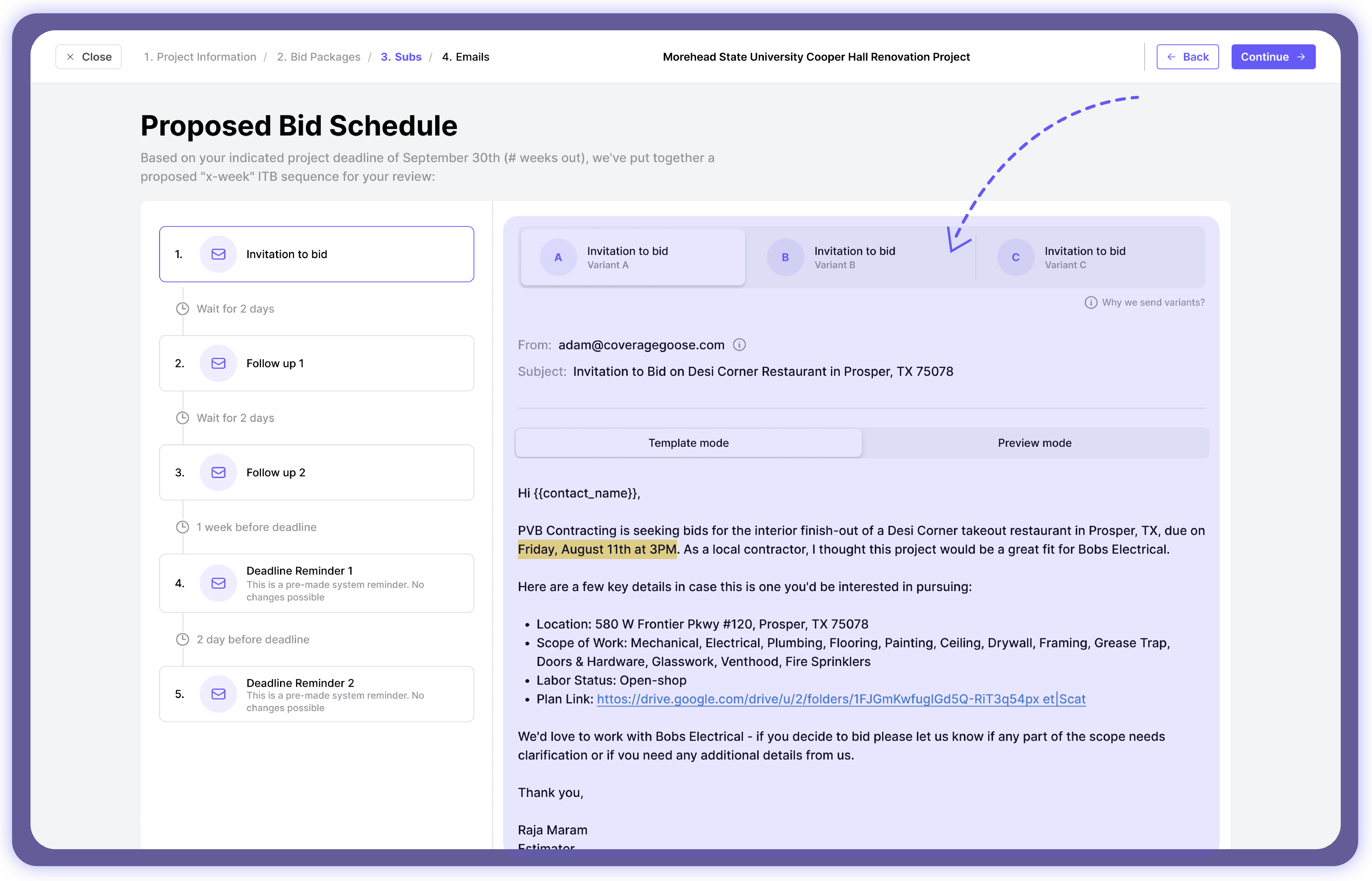
We also encourage upfront dialogue, and our automated follow-up sequences ensure timely bid confirmations, leading to higher response rates. In fact, our personalized bid invites have helped users achieve an average 30% increase in responses from the right subs.
How Reliable Is the Subcontractor Database?
Procore’s subcontractor database does offer some value. You can filter searches by trade, business classifications (MBE/WBE/DBE), cost codes, location, and project team ratings. These filters can help compile a list of qualified bidders quickly.
However, Procore's database has a major flaw: it relies on subcontractors to update their own information. Many subs don't do this regularly, meaning the information can be wildly inaccurate. For instance:
- Subs may claim to work in areas they no longer cover
- Trades can be mismapped
- Retired employees may still remain listed
At Downtobid, we tackle these issues head-on with our multi-step verification process; we:
- Look into the subcontractor’s portfolio to infer their project and location preferences, giving you deeper insights.
- Reach out directly to confirm contacts and ensure these companies are still active.
- Use AI to accurately categorize trades based on what the subcontractor lists on their website, making sure the information aligns with what a GC or project manager actually needs.
- Pull from Google Maps, local trade associations, and other sources to verify local subs to make sure you have the most up-to-date information.
- Update contact data with every response, keeping everything fresh and reliable.
Our approach results in a more accurate, up-to-date database. You can filter by various certifications (HUB/MWBE/etc.) and access AI-mapped trades with additional details that matter to you.
To give you a better idea of how this subcontractor network looks like
- Here's an example sublist directory: https://downtobid.com/contractors/hvac/dallas
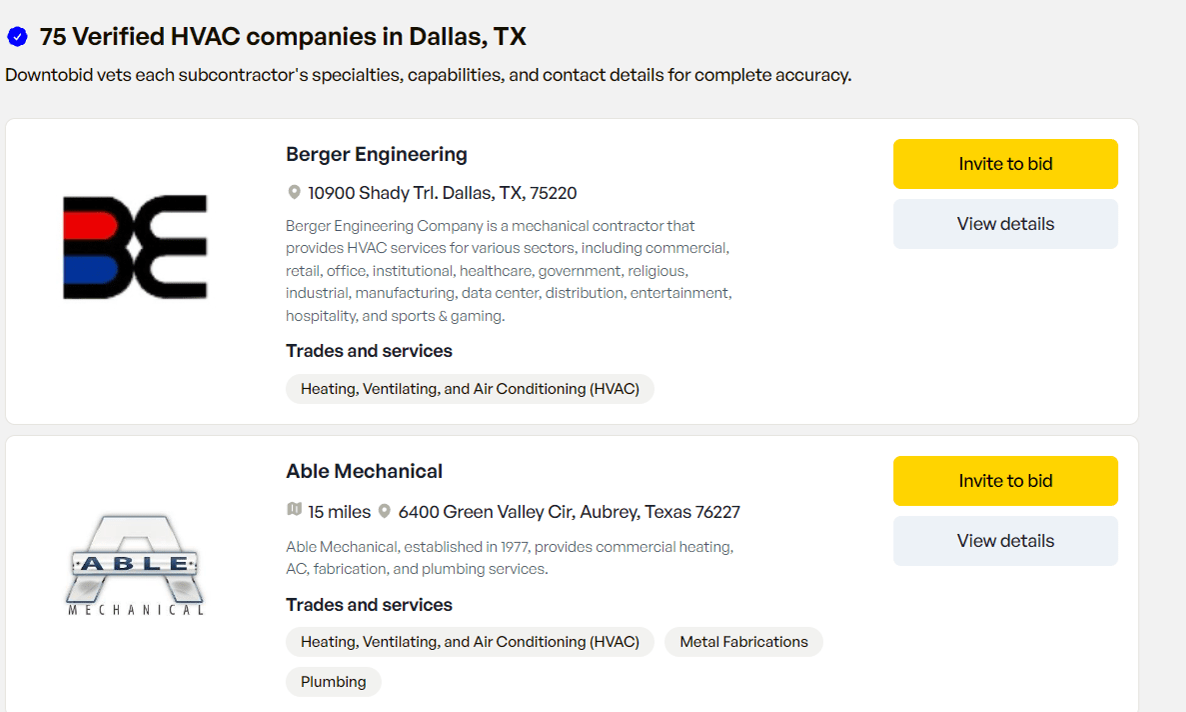
- Here's an example profile: https://downtobid.com/company/airpro-mechanical
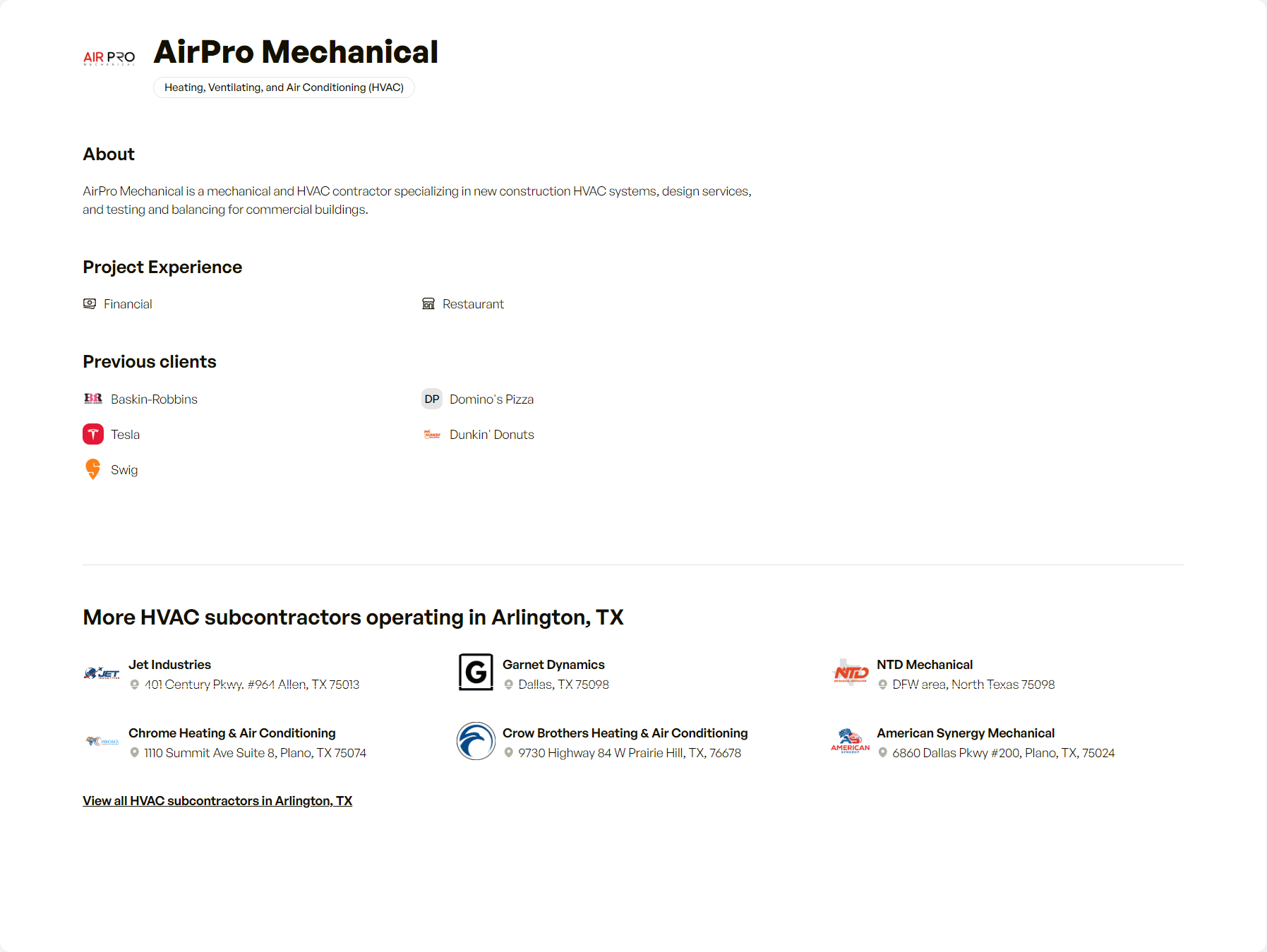
How Simple Is Creating Bid Packages?
Procore's bid package setup follows a three-step workflow:
- Enter general information: title, number, due date, project overview, and bidding instructions.
- Attach drawings, specifications, and documents of the construction site properly. Procore links these files from its other tools, allowing one-click updates when changes occur.
- Add bidders and send invitations.

Once bids start rolling in, the project management software lets you monitor bid coverage with quick insights into bid activity — bidding intent status, submission status, and any notes documented along the way. It also centralizes all critical communications, so you know exactly which bidders have seen the latest changes and addenda.
While this system offers some benefits, it falls short in key areas.
One of the biggest issues is that it doesn’t really address the time-consuming page-turn process — a common pain point for many contractors in the construction industry. It also relies on simplistic 'Yes, No, Undecided' bidding intent buttons, making it hard to tell which subs are seriously considering your project.
Streamlining Page-Turns
GCs face a time-consuming challenge with every project. They spend 2-3 hours poring over extensive construction documents from complex projects to determine which subs they need quotes from. This process involves:
- Scanning through 100-page plans to manually identify all the necessary scopes (like electrical, mechanical, drywall) and then inviting the appropriate subs.
- Analyzing key notes, general notes, and schedules to understand each trade’s scope and generate scope line-items.
- Tracking changes from addenda and understanding how they affect each trade, the project schedule, or the project financials
- Comparing plans side-by-side, scanning through construction text, and highlighting critical details such as material substitutions, exclusions, and special requirements.
Procore lacks a solution for this time-drain. Downtobid, however, addresses it directly.
With Downtobid, you simply upload your plans, and in 20-30 minutes, our AI Copilot reads construction plans:
- Identifies all scopes it detects in the plans
- Provides brief descriptions of where to find each scope
- Explains why each scope was detected
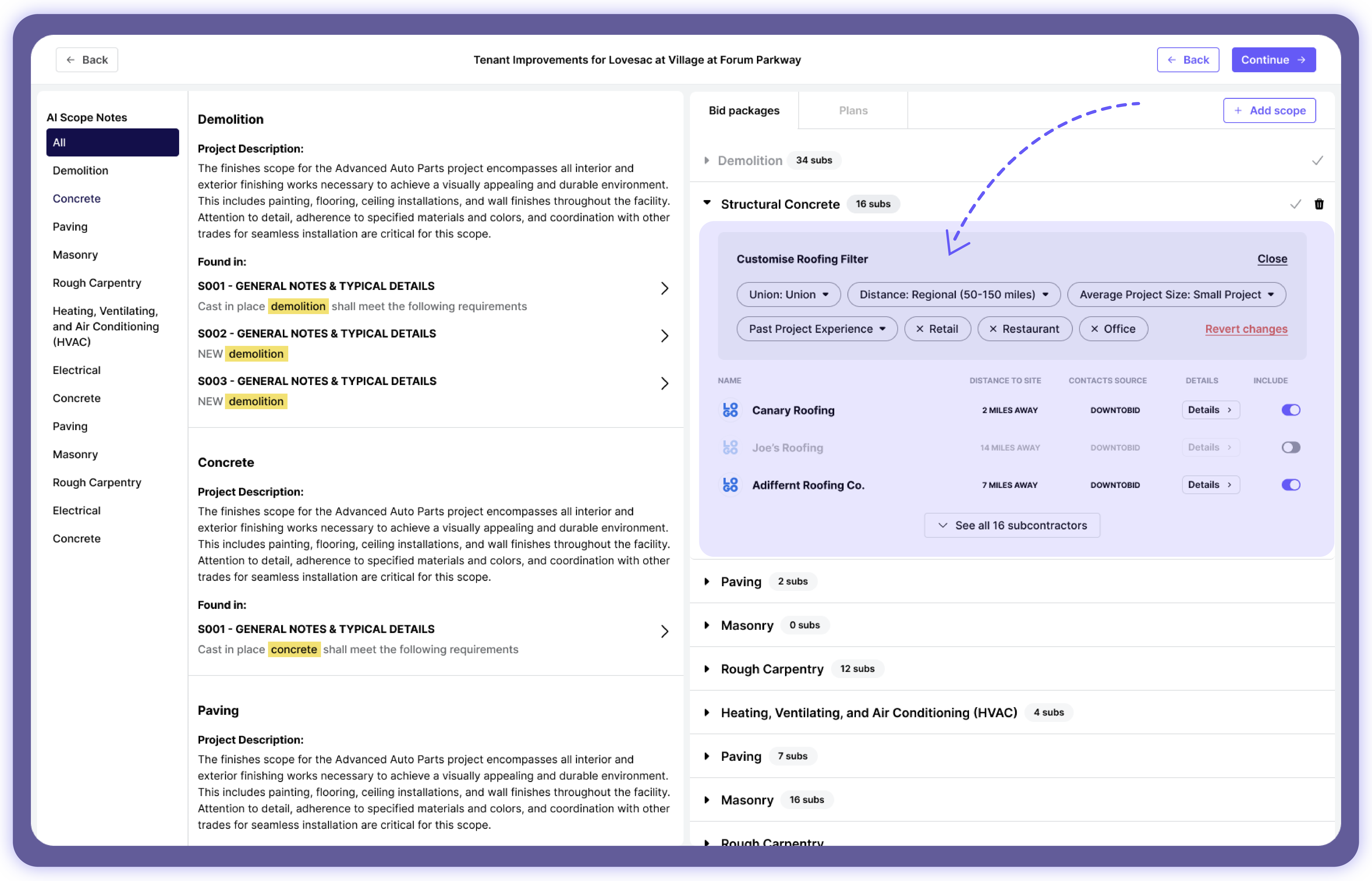
You also receive a list of recommended local, qualified subs to invite. You can use your own subcontractor list or Downtobid's suggestions to tailor your invitations. The AI even drafts personalized ITBs in just a few seconds, helping you build connections with subs from the start.
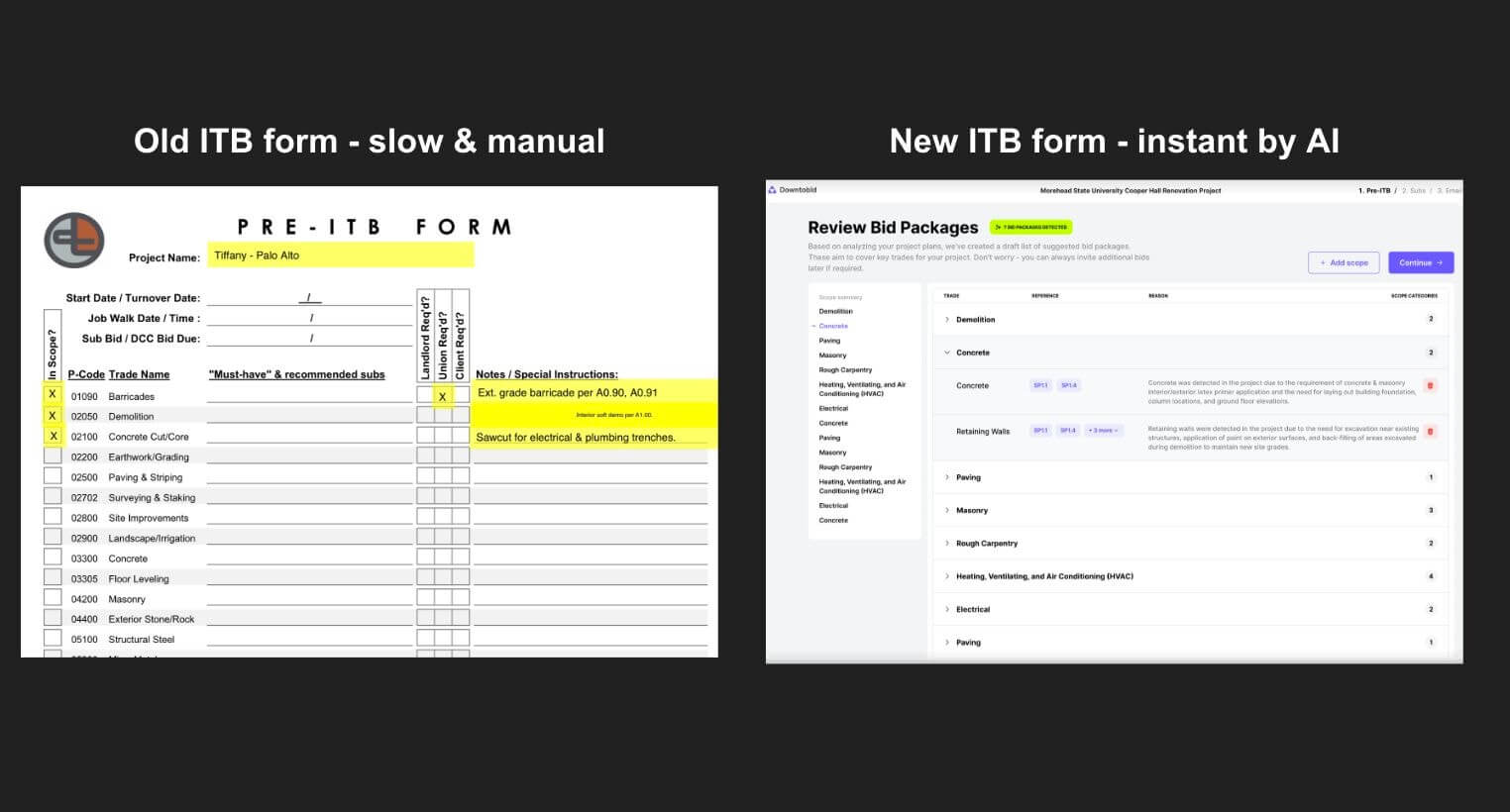
This approach slashes your prep time from hours to minutes, freeing you to focus on the more demanding aspects of being a construction manager, rather than drowning in document analysis.
Engagement and Intent Tracking
Procore's use of bidding intent buttons can sometimes create a significant issue for GCs. These buttons typically get low engagement, resulting in most subcontractors being listed as "Undecided."
The problem worsens due to the inaccurate contact data we've mentioned above. When you call potential subs to check and confirm bidding status, you often reach invalid or incorrect contacts.
For these reasons, gauging true bidding intent can be difficult. You can find yourself wasting valuable time chasing leads that may not pan out, or miss opportunities with interested subs who simply didn't click a button.
In contrast, Downtobid takes a different approach. We don’t rely on traditional intent buttons. Instead, we track real interactions for more accurate engagement metrics. Our system monitors planroom activity, noting which subs view documents and how often.
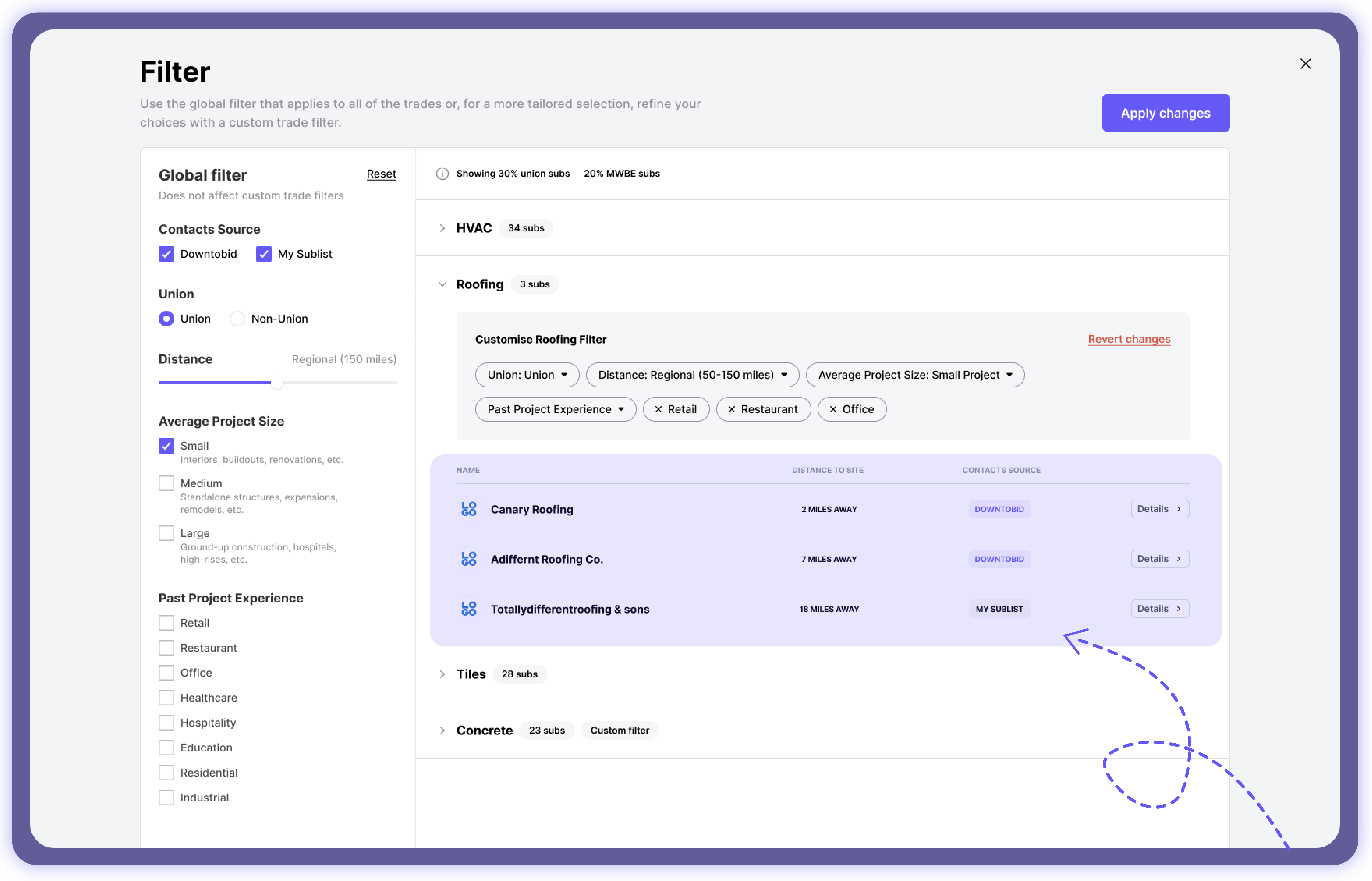
This way, you get a clearer picture of which subs are truly engaged; you'll know who to focus your follow-up efforts on, saving time and improving your bid coverage.
Is Procore a Cost-Effective Choice?
Procore operates on a custom pricing model, meaning you pay for exactly what you need. The platform determines pricing based on the products you choose and your Annual Construction Volume (ACV) —the amount of construction work you manage through their platform each year.
Procore argues that by tying pricing to ACV, the software grows with your business. As your construction projects increase, so does the value you get from Procore.
It sounds good in theory, but it also means they don’t publicly disclose their pricing details. This makes it difficult to figure out what you’ll actually be paying until you schedule a consultation to get a ballpark figure. Plus, there could be hidden costs for things like implementation, training, or additional services that aren’t immediately obvious.
Now, compare that to Downtobid. We like to keep things simple and upfront. You can start using our software for free – no strings attached. This plan lets your entire team get started on two active projects at once, which is perfect if you’re already using other software and want to try something new without any risk.
If you need more firepower, you can opt for the Basic Plan for up to 3 users per month, and the Pro Plan lets you have up to 10 users.
No hidden fees, no surprise costs — just straightforward pricing that lets you get the job done.
Final Words: Is Procore Worth It?
Procore offers a wide range of tools for GCs to manage construction projects, but some aspects, like construction bidding, might benefit from more focus.
The lack of transparency in pricing doesn’t help either. Knowing the cost upfront would make life a lot easier for anyone trying to figure out if the platform fits their budget — without having to schedule a consultation just to get a ballpark figure.
If you’re after construction management software that gets bidding right without the hefty price tag and offers clear pricing, try Downtobid.
Downtobid streamlines the entire bidding process by identifying project scopes, recommending the best subcontractors, and even drafting personalized ITBs. And the best part? You can get started for free. Try a demo today and experience firsthand how our platform can transform your preconstruction process.